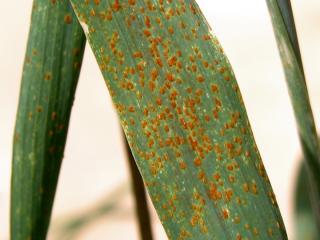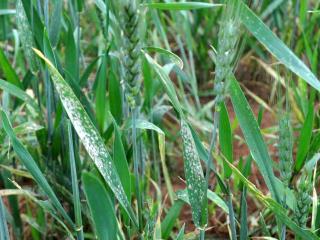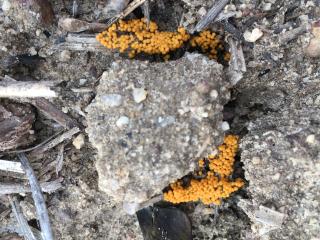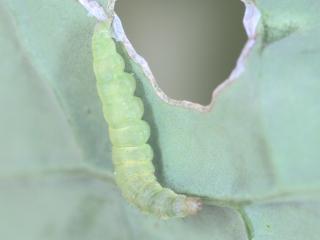Barley and wheat disease update
Barley leaf rust
- Gibson
- Esperance
Plant pathologist Andrea Hills (DPIRD) has reported finding barley leaf rust (BLR) on Oxford, Flinders, Maltstar and Granger plants at a DPIRD trial site near Gibson. The plants are at the stem elongation stage. The La Trobe barley at this trial was not showing any rust. Very low levels of Spot-type net blotch (STNB) were present and the barley varieties Granger and Flinders were also displaying signs of physiological leaf spotting, which is expressed when plants are under stress.
Esperance agronomists have also reported that Oxford barley crops in the Esperance area are also being affected by BLR.
For more information on BLR and how to manage it refer to the department’s Diagnosing barley leaf rust page and the 2017 PestFax newsletter Issue 4 Barley and wheat leaf rust warning for 2017 article.
Barley net blotches
- Cadoux
- Yerecoin
- Tammin
- Brookton
David Stead (Anasazi Agronomy) reports seeing both forms of net blotch in stressed barley crops, particularly the varieties La Trobe, Scope, Spartacus and Bass, across his advisory district that encompasses the shires within Cadoux to Yerecoin and Tammin to Brookton. The barley plants are at end of tillering. Growers will spray fungicide in combination with herbicides when spraying wild radish.
For further information on symptoms and management of blotches see the department’s Managing spot type net blotch in continuous barley and Managing net-type net blotch of barley in Western Australia pages.
Wheat leaf rust
- Condingup
Local Esperance agronomists have reported about low levels of wheat leaf rust (WLR) in a crop of Mace in the eastern area of the district.
For more information on WLR see the department’s Diagnosing leaf rust of wheat and the 2017 PestFax Issue 12 newsletter article Leaf rust in wheat.
Wheat powdery mildew
- Coomalbidgup
Local Esperance agronomists have reported of wheat powdery mildew in crops in the very high rainfall areas of the district. Affected crops include Mace and very early sown Trojan.
For more information refer to the department’s Managing powdery mildew in wheat.
For the latest information on managing barley diseases refer to the 2017 PestFax Issue 10 Barley disease update and current management recommendations article.
Barley and wheat foliar fungicide information can be found at DAFWA’s Registered foliar fungicides for cereals in Western Australia.
For more information contact Kithsiri Jayasena, Plant Pathologist, Albany on +61 (0)8 9892 8477, Geoff Thomas, Plant Pathologist, South Perth on +61 (0)8 9368 3262, Andrea Hills, Plant Pathologist, Esperance on +61 (0)8 9083 1144 or Ciara Beard, Plant Pathologist, Geraldton on +61 (0)8 9956 8504.
Growers are urged to diagnose what is causing patches or uneven growth in their crops
- Cadoux
- Yerecoin
- Tammin
- Brookton
David Stead (Anasazi Agronomy) reports that he is seeing distinct patches in cereal crops right across his advisory district (shires within Cadoux to Yerecoin and Tammin to Brookton) that he strongly suspects are caused by rhizoctonia root rot. The cereal plants in this area are generally at end of tillering. Paddocks with a history of rhizoctonia that had Uniform® or a similar in-furrow fungicide registered for control of the pathogen are noticeably less patchy. Dry conditions are exacerbating the patchiness of infected paddocks.
Growers are urged to identify the causal agent/s of any cereal crops with patching or uneven growth.
Distinct patches are often evident when the primary roots of plants are infected early, while infection of the crown roots later in the season may cause an uneven crop. It is important to know that patches are not unique to rhizoctonia. There are other diseases including root lesion nematodes (RLN) and take-all as well as non-disease issues that can cause them. In particular, patches caused by rhizoctonia or RLN are difficult to distinguish without close inspection of the plant roots and often require further laboratory tests to isolate rhizoctonia or extract any nematodes.
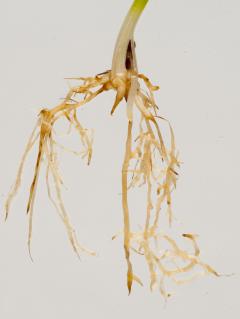
There is nothing that can be done in season to control root diseases. An application of nitrogen post-sowing may aid recovery, but does not prevent root damage. Plant pathologist Daniel Huberli says that before the next crop is planted, it is important that the disease or issue causing the patches is confirmed in order to put the right management plan in place for 2018.
For diagnosis of root disease or nematode problems in-crop, carefully dig up symptomatic plants from the edge of the patch (not the centre) as well as healthy plants from outside the patches. The department’s YouTube video How to take a plant sample shows the correct method to use. Plants can be sent to the department’s Diagnostic Laboratory Services, Department of Primary Industries and Development, Western Australia, Reply Paid 83377, 3 Baron-Hay Court, South Perth WA 6151.
Keeping disease inoculum levels at low levels is the most effective way to minimise crop losses from root diseases and this can be achieved by thinking long-term and implementing management practices over more than one cropping season.
If you have confirmed your paddock has rhizoctonia with large amounts of the crop affected this year, the best option would be to place the paddock into a grass-free break crop in 2018, such as canola, pulse or pasture. Canola has been shown to reduce the level of disease in the following cereal crop.
For detailed information about management options for rhizoctonia read the GRDC's Tips and Tactics Rhizoctonia factsheet.
For more information and pictures of disease symptoms refer to the department’s;
- Diagnosing rhizoctonia root rot in cereals page
- Root disease under intensive cereal production systems page
- Rhizoctonia in your paddocks YouTube video.
For more information contact Daniel Hüberli, Plant Pathologist, South Perth on +61 (0)8 9368 3836.
Slime moulds
- Bindi Bindi
Clare Johnston (Elders) recently found some slime mould in a canola crop with wheat stubble east of Bindi Bindi. The slime was only found in one area of the paddock and only in the one paddock on the property. The grower had not seen it before.
Slime moulds appear as patches of watery or jelly-like slimy material on low lying plant material. After a few days the jelly-like material produces fruiting bodies that are commonly ash grey, though in some instances they may be bright yellow or red. These fruiting bodies usually occur in great numbers on the affected plant material and may cover an area of up to a square metre.
Warm wet weather combined with high nitrogen levels provide a good environment for the slime moulds.
The slime moulds should disappear if a couple of dry warm days are experienced.
If you do have concerns about your livestock eating slime moulds please contact your local veterinary officer.
For more information refer to the department’s Slime moulds.
For more information contact Ravjit Khangura, Research Officer, South Perth on +61 (0)8 9368 3374.
Aphid activity update
Canola aphid activity
- Cadoux
- Yerecoin
- Tammin
- Doodlakine
- Brookton
David Stead (Anasazi Agronomy) reports seeing an explosion of turnip and cabbage aphids on budding to early flowering canola crops recently across his advisory district which covers the shires within Cadoux to Yerecoin and Tammin to Brookton. Particularly in moisture stressed crops. He is also seeing green peach aphids (GPA) damaging canola plants that are six leaves or less.
A grower has reported GPA in his canola (variety unknown) at Doodlakine.
Cereal aphid activity
- Gairdner
- Hopetoun
- Coomalbidgup
Crop protection officer Alice Butler (DPIRD) has reported finding oat aphids in a tillering Harper wheat crop near Gairdner.
Plant pathologist Andrea Hills (DPIRD) has found corn aphids in La Trobe barley near Hopetoun. 1-10% of tillers/flower spikes were infested. The barley was at the stem elongation stage and also had very low levels of spot-type net blotch (STNB). Andrea also found small populations of oat aphids in stem elongation stage barley in a NVT trial near Coomalbidgup.
Remember, if you are unsure of what aphid species you are finding in your crops you can use the PestFax Reporter app to attach up to three images of the aphid(s) and request that a department entomologist identify or confirm the aphid species via an email or phone response.
For more information on aphids refer the department’s;
- Protecting WA Crops Issue 3 newsletter Aphids – WA’s insect problem children
- Aphid management in canola crops page
- Diagnosing cereal aphids page.
For a list of insecticides registered for use on aphids in canola and cereals see the department’s Autumn winter insecticide guide 2017.
For more information contact Svetlana Micic, Research Officer, Albany on +61 (0)8 9892 8591 or Dustin Severtson, Development Officer, South Perth on +61 (0)8 9368 3249.
Diamondback moths may be a problem this spring
- Cadoux
- Yerecoin
- Tammin
- Brookton
David Stead (Anasazi Agronomy) reports finding diamondback moth (DBM) caterpillars and adults in canola crops everywhere across his advisory district which encompasses the shires within Cadoux to Yerecoin and Tammin to Brookton. They are in considerable numbers and there are new moths as well, indicating that they have completed one life cycle already. David is concerned that DBM populations could 'get ugly' in spring.
Growers and consultants are advised to monitor for DBM, especially from August onwards, by doing at least four lots of 10 sweeps with an insect net at various locations in each crop. DBM caterpillars drop from plants when disturbed and bashing some plants, especially those with holes in leaves, over an ice cream container is a good initial indication of their presence if you don’t have a sweep net handy.
DBM are difficult to control because they breed prolifically and insecticide sprays have limited coverage in advanced canola canopies. Brassica weeds (for example, radish) and volunteer canola present prior to sowing forms a green bridge and can often ramp up populations prior to spring when they are usually causing damage to crops. Cold winter weather will hinder their reproduction and spread to some extent, but populations of DBM present in crops can reproduce rapidly and unpredictably so monitoring is recommended.
Thresholds for control are:
- pre-flowering (stressed crop) - 30 or more grubs per 10 sweeps
- pre-flowering (no stress) - 50 or more grubs per 10 sweeps.
For more DBM information refer to DAFWA’s Diagnosing diamondback moth and the GRDC's Diamondback moth fact sheet.
For more information contact Dusty Severtson, Development Officer, South Perth on +61 (0)8 9368 3249.



